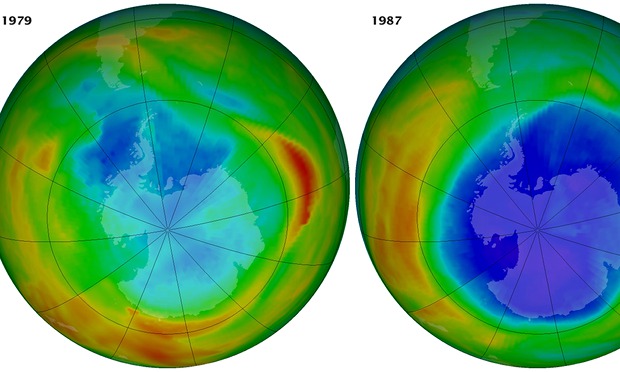Thirty years on, scientist who discovered ozone layer hole warns: ‘it will still take years to heal’
Ozone layer
The Observer
The lessons of a landmark moment in climate research have not been learned
Two images that raised global alarm over the ozone layer.
Two images that raised global alarm over the ozone layer. Photograph: NASA/Corbis
Robin McKie
It is popularly viewed as one of the greatest environmental success stories of modern times. Exactly 30 years ago, UK scientists announced they had discovered a hole in the ozone layer in the atmosphere above Antarctica.
The hole threatened to spread, allowing increased levels of cancer-causing radiation from the sun to reach the ground. Within a few years of the discovery it was agreed to set up the Montreal Protocol, which banned the manmade chemicals responsible for depleting ozone in the upper atmosphere.
But last week, one of the three UK scientists who discovered the hole in 1985 warned that the real lessons of the story had still not been learned. “Yes, an international treaty was established fairly quickly to deal with the ozone hole, but really the main point about its discovery was that it shows how incredibly rapidly we can produce major changes to our atmosphere and how long it takes for nature to recover from them,” said Jon Shanklin of the British Antarctic Survey.
“Clearly, we still do not understand the full consequences of what we did then because we are still inflicting major changes on the atmosphere. Then it was chlorofluorocarbons; today it is greenhouse gases.”
In 1985, Shanklin was working – “as a general dogsbody” as he put it at the British Antarctic Survey, along with colleagues Brian Gardiner and the late Joe Farman. At the time, there was some speculation that spray cans and supersonic jets such as Concorde might be damaging the upper atmosphere’s ozone layer that protects us from the sun’s ultra-violet radiation.
Using a device developed in the 20s, the Dobson Ozone Spectrophotometer, the three analysed amounts of ozone in the atmosphere over the Antarctic. “I was the backroom boy who calibrated the Dobson and fed results from it into our very primitive computer,” said Shanklin.
The results revealed major changes in ozone levels over the Antarctic at certain times of the year, but at first the team could see no pattern. “We thought it might just be random fluctuations. Then I did a really careful calibration and found a pattern: every spring a major hole appeared in the ozone layer over the Antarctic, one that was getting bigger and bigger each year. It was Joe [Farman] who worked out that the hole was being created by chemicals called chlorofluorocarbons that were reacting with the ozone.”
Advertisement
The team published their results in Nature in May 1985 and their research was later backed by Nasa who used their satellites to confirm the ozone hole’s existence. Other researchers later confirmed that CFCs were the likely culprits and within a couple of years the Montreal agreement led to the banning of the production of CFCs, an example of exceptional international co-operation according to former UN secretary-general Kofi Annan, who has since described it “as the single most successful international agreement to date”.
But it was relatively easy to find a substitute for the CFCs – then widely used for refrigeration – that were causing ozone depletion, Shanklin pointed out, and that in turn made it fairly straightforward to establish the Montreal protocol. “We forget that 25 years later there is, in strict scientific terms, no statistically significant recovery in ozone over Antarctica, although there a few signs of improvement,” said Shanklin, who is now 61. “The CFCs we put up there will take a long time to dissipate and it will probably take us well into the second half of the century before the ozone layer recovers fully.”
Thus a relatively easily cured atmospheric affliction will still take decades to be corrected. By contrast, the greenhouse gases we are now putting into the atmosphere have no substitutes that have broad political acceptance at present. For good measure, we are also pumping them out on a far greater scale. “The ozone hole story tells us that it is very easy to cause major changes to the atmosphere – it only took about 10 years to develop – but it is very difficult to restore equilibrium,” said Shanklin. “Unfortunately, we don’t seem to have learned that lesson. We are burying our heads in the sand about the changes we’re bringing about. On the other hand, carbon emissions are now on the political agenda, so there is some hope.”







Follow Us!